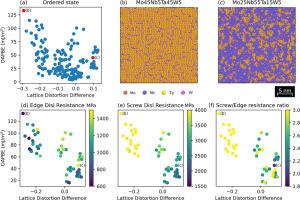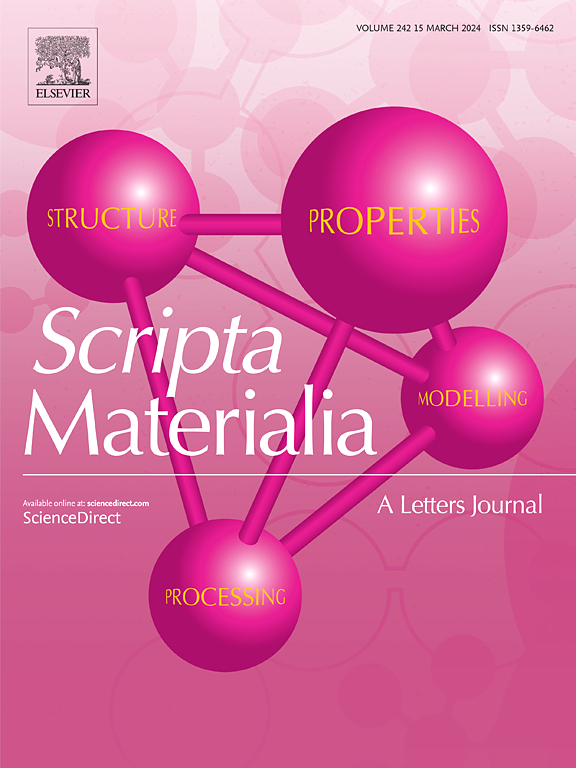基于图神经网络的螺旋-边缘位错滑移差校正加速了难熔高熵合金的局部有序态探索
IF 5.6
2区 材料科学
Q2 MATERIALS SCIENCE, MULTIDISCIPLINARY
引用次数: 0
摘要
难熔高熵合金(RHEAs)表现出独特的位错行为,这是其卓越力学性能的基础。然而,巨大的组成空间和复杂的局部原子环境使得位错滑移机制难以定制。在本研究中,我们证明了通过共同调节扩散-反相边界能(DAPBE)和晶格畸变差(LDD)可以有效地调节具有局部有序的RHEAs的位错滑移抗力。使用由物理信息图神经网络支持的高吞吐量框架,我们通过具有机器学习潜力的原子模拟系统地探索了MoNbTaW组成空间。研究结果表明,增加DAPBE可以增强对螺旋位错滑移的抵抗力,而增加LDD可以减弱这种效应,但可以增强对边缘位错滑移的抵抗力。值得注意的是,具有高DAPBE和LDD的组合物产生平衡的位错响应。本研究提供了一种设计策略,通过局部排序调整材料的固有参数来提高BCC RHEAs的强度-延性协同。本文章由计算机程序翻译,如有差异,请以英文原文为准。

Tuning screw-to-edge dislocation slip discrepancy via graph neural network–accelerated exploration of local ordered states in refractory high-entropy alloys
Refractory high-entropy alloys (RHEAs) exhibit unique dislocation behaviors that underpin their exceptional mechanical properties. However, the vast compositional space and complex local atomic environments make it difficult to tailor dislocation slip mechanisms. In this study, we demonstrate that dislocation slip resistance in RHEAs with local ordering can be effectively tuned by jointly adjusting the diffuse-antiphase-boundary energy (DAPBE) and lattice distortion difference (LDD). Using a high-throughput framework enabled by a physics-informed graph neural network, we systematically explored the MoNbTaW compositional space through atomistic simulations with machine-learning potentials. Our findings reveal that increasing DAPBE strengthens resistance to screw dislocation slip, while increasing LDD diminishes this effect but enhances the resistance to edge dislocation slip. Notably, compositions exhibiting both high DAPBE and LDD yield a balanced dislocation response. This study offers a design strategy to improve the strength–ductility synergy in BCC RHEAs by tuning intrinsic material parameters via local ordering.
求助全文
通过发布文献求助,成功后即可免费获取论文全文。
去求助
来源期刊

Scripta Materialia
工程技术-材料科学:综合
CiteScore
11.40
自引率
5.00%
发文量
581
审稿时长
34 days
期刊介绍:
Scripta Materialia is a LETTERS journal of Acta Materialia, providing a forum for the rapid publication of short communications on the relationship between the structure and the properties of inorganic materials. The emphasis is on originality rather than incremental research. Short reports on the development of materials with novel or substantially improved properties are also welcomed. Emphasis is on either the functional or mechanical behavior of metals, ceramics and semiconductors at all length scales.
 求助内容:
求助内容: 应助结果提醒方式:
应助结果提醒方式:


